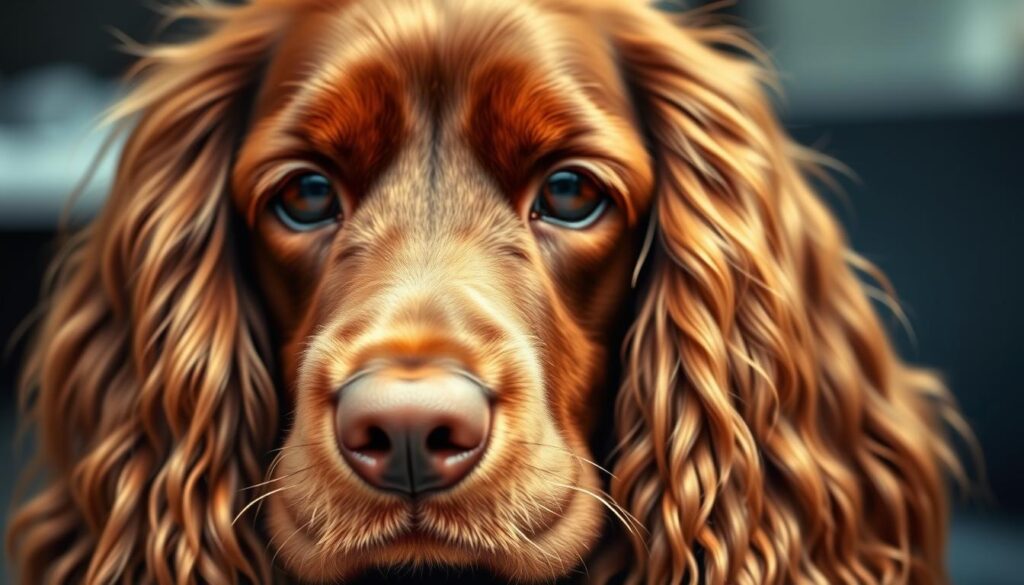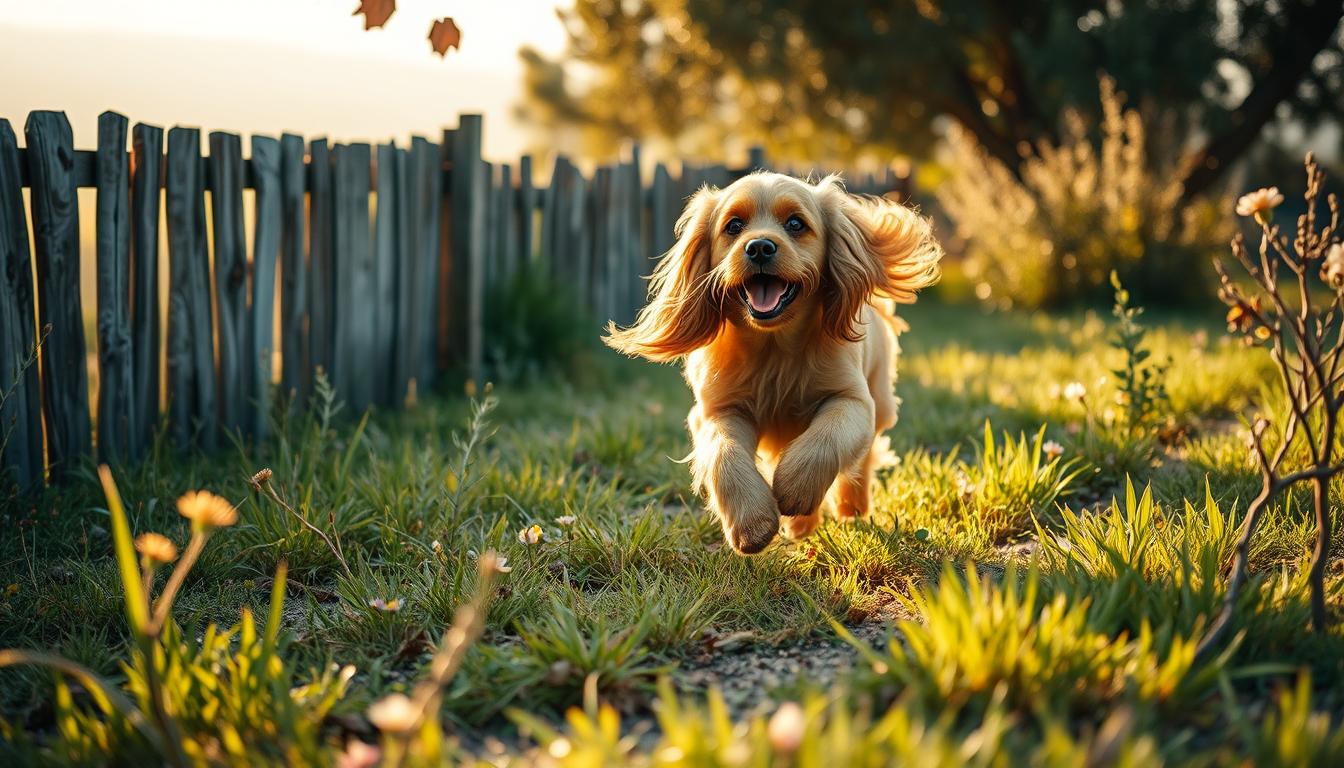Known affectionately as the ‘Merry Cocker’, this breed’s boundless cheer has charmed households globally. Their trademark wagging tails and bright-eyed curiosity reflect a zest for life that turns everyday moments into adventures. Whether snuggling on the couch or exploring the backyard, these dogs thrive when sharing experiences with their humans.
Originally bred as skilled gundogs, the English Cocker Spaniel carries a legacy of stamina and focus. This heritage shapes their love for interactive games like fetch or scent-based challenges. Modern families benefit from their adaptable spirit—they’re as content with beach walks as they are mastering obedience drills.
Their lively personality demands engagement. Without regular play or training sessions, boredom can lead to mischief. Structured routines and puzzle toys help channel their energy constructively, making them ideal for active Aussie households.
Key Takeaways
- Nicknamed ‘Merry Cockers’ for their joyful, tail-wagging demeanour
- Playfulness rooted in hunting lineage requiring mental challenges
- Daily exercise prevents restlessness in home environments
- Excel in family settings through gentle, people-focused tendencies
- Positive reinforcement training enhances natural eagerness to please
Introduction to Cocker Spaniel Playful Nature
Originating as skilled hunters, the English Cocker Spaniel carries a legacy that fuels their lively disposition. This breed’s nose-to-ground curiosity and spring-loaded energy transform routine walks into thrilling expeditions. Their heritage as working dogs demands activities that engage both body and mind.
High-energy companions thrive when given purposeful tasks. Puzzle feeders, scent games, or agility courses satisfy their instinctual drive. Owners often notice how quickly they master new tricks – a testament to their sharp intelligence and eagerness to connect.
| Working Heritage | Modern Family Life |
|---|---|
| Field retrieval drills | Interactive fetch sessions |
| 8+ hours of daily activity | 60-90 minutes of structured play |
| Independent problem-solving | Human-guided training exercises |
This breed’s temperament shines brightest when sharing adventures. Whether splashing through coastal rock pools or learning obedience commands, their enthusiasm remains unwavering. Regular engagement isn’t just fun – it’s vital for maintaining their cheerful outlook and preventing restlessness in suburban homes.
History and Origins of Cocker Spaniels
Tracing their lineage to medieval Europe, these dogs carry centuries of purpose in their DNA. Artistic evidence suggests ancestors resembling modern spaniels existed over 2,000 years ago, though formal documentation began in 14th-century Spain.
The Breed’s Roots in Hunting
Early English Cocker lines specialised in flushing woodcock through thick undergrowth. Their compact size and spring-loaded agility made them ideal for navigating dense terrain. Hunters prized their relentless work ethic – a trait still evident during energetic fetch sessions today.
By the 1800s, distinct differences emerged between springer and cocker types. The latter’s name became official, derived from their unmatched skill with the elusive game bird. Field trials showcased their precision, cementing their reputation as premier gundogs.
Evolution into a Beloved Family Pet
Victorian-era breeders began refining temperament alongside hunting prowess. Selective breeding softened edges without diminishing intelligence or stamina. This dual focus created adaptable companions equally skilled in retrieving game or cuddling on lounge rooms.
Modern cocker spaniels retain their ancestors’ drive through playful antics and problem-solving zeal. Their transition from field to family home succeeded because breeders preserved core traits: loyalty, curiosity, and that signature tail-wagging enthusiasm.
Physical Appearance and Unique Features
A hallmark of this breed lies in its visually striking features that blend form and function. Their silky coat and signature pendulous ears create an elegant silhouette recognised worldwide. These traits aren’t just decorative – they’re rooted in the dog’s working history, offering practical advantages that persist in modern companions.

Elegant Coat and Striking Ears
The flowing, medium-length fur comes in solid or parti-colour patterns, from golden russets to sleek blacks. Regular brushing prevents mats, especially around feathering on legs and chest. Those iconic ears demand weekly checks for debris – their folded shape traps moisture, requiring vigilance in Australia’s humid climates.
Comparing the English and American Types
Though sharing core traits, subtle differences define these cousins:
| Feature | English Type | American Type |
|---|---|---|
| Height | 15-17 inches | 14-15 inches |
| Weight | 26-34 pounds | 24-28 pounds |
| Head Shape | Moderate stop | Domed skull |
The English variant’s athletic frame suits active lifestyles, while the compact American type adapts well to urban living. Both share expressive eyes that radiate intelligence, making them irresistible to families seeking loyal pets.
Core Personality and Temperament
At the heart of this breed’s charm lies a dynamic personality built for companionship. Their temperament blends unwavering loyalty with spirited enthusiasm, creating dogs that thrive on shared activities and heartfelt connections. This balance makes them equally suited to quiet evenings or action-packed adventures.

Affectionate, Loyal and Eager to Please
These dogs form intense bonds with their human families, often shadowing owners from room to room. Their expressive eyes and gentle nudges reveal a deep need for closeness. Eagerness to please shines during training sessions, where they respond enthusiastically to praise and treats.
| Working Line Traits | Family Companion Traits |
|---|---|
| Focus during field tasks | Attention during obedience training |
| Independent decision-making | Human-guided problem solving |
| High stamina for hunting | Endurance for play sessions |
Playful and Energetic Traits
Puppy-like energy defines their approach to life, whether chasing balls or learning new tricks. This vitality requires daily outlets – think brisk walks combined with puzzle toys. Their intelligence transforms simple games into brain-teasing challenges that prevent boredom.
Socialisation shapes their interactions with kids and pets. Early exposure helps manage their exuberant greetings. While generally friendly, their zest might overwhelm timid companions without proper guidance.
Cocker Spaniel Playful Nature in Focus
Exploring the world through scent-driven adventures defines this breed’s approach to daily life. Their exceptional olfactory skills transform simple walks into detective missions, with noses scanning every bush and footpath. This trait makes them brilliant candidates for search-and-rescue training or scent-based games that honour their gundog lineage.
High-energy pursuits form the cornerstone of their wellbeing. A mix of physical exertion and mental challenges prevents restlessness – think agility courses in local parks or backyard hide-and-seek with favourite toys. Water-based activities often become firm favourites, leveraging their webbed feet and water-resistant coats inherited from working ancestors.
| Activity Type | Key Benefits |
|---|---|
| Scent games | Stimulates natural hunting instincts |
| Agility training | Builds coordination & confidence |
| Water play | Supports joint health & endurance |
Interactive sessions strengthen family bonds more effectively than solo play. These clever companions thrive when humans join the fun, whether teaching new commands or racing through obstacle courses. Neglecting daily engagement risks destructive habits – a bored dog might redesign your garden or audition as a neighbourhood alarm system.
Structured routines combining walks, training, and puzzle toys keep tails wagging rhythmically. Aussie owners find beachcombing trips or bushland explorations perfect for burning energy while satisfying that insatiable curiosity. Remember: a tired Cocker Spaniel is a contented companion.
Pros and Cons of the Breed
When choosing a four-legged family member, understanding a breed’s balance of traits helps owners prepare for lifelong companionship. This beloved dog offers countless joys but requires awareness of specific care commitments common in Australian climates.
Strengths and Endearing Qualities
These dogs excel as family pets due to their gentle nature and social adaptability. Their intelligence shines through quick learning – many master complex commands faster than average breeds. Early socialisation helps them bond effortlessly with children, seniors, and other household pets.
| Strengths | Considerations |
|---|---|
| Affectionate temperament | Daily brushing & grooming |
| High trainability | Ear infection risks |
| Urban/rural adaptability | Separation anxiety tendencies |
Potential Challenges and Considerations
Weekly grooming sessions become essential to manage their lush coat and prevent matting. Floppy ears need regular cleaning to avoid moisture-related issues, particularly in humid regions. Owners should also establish consistent routines to curb food guarding or excessive barking.
Proactive training minimises problems like destructive chewing during alone time. While their exercise needs suit active households, busy professionals might struggle to meet daily activity requirements. Coastal walks or backyard agility courses often provide ideal energy outlets.
Daily Care and Routine Needs
Maintaining their vibrant spirit requires consistent daily care routines tailored to energetic breeds. Aussie owners benefit from establishing set schedules for meals, walks, and interactive play. Morning beach runs or evening backyard games help meet exercise requirements while strengthening human-animal bonds.
Weekly grooming sessions prove essential for managing silky coats. Brushing prevents tangles in feathering around legs and paws. Owners should check ears after outdoor adventures, as their shape traps moisture in humid regions – a quick wipe with vet-approved solution prevents issues.
Balanced diets fuel their active lifestyles without causing weight gain. Measure portions carefully and limit treats during training. Pair mealtimes with puzzle feeders to engage sharp minds. Remember: hydration matters doubly during summer bushwalks.
Proactive preventative care saves long-term hassles. Schedule regular nail trims and dental checks alongside annual vet visits. Local parks become perfect venues for combining physical activity with socialisation opportunities. A structured routine ensures these clever companions remain healthy, happy family members for years.



